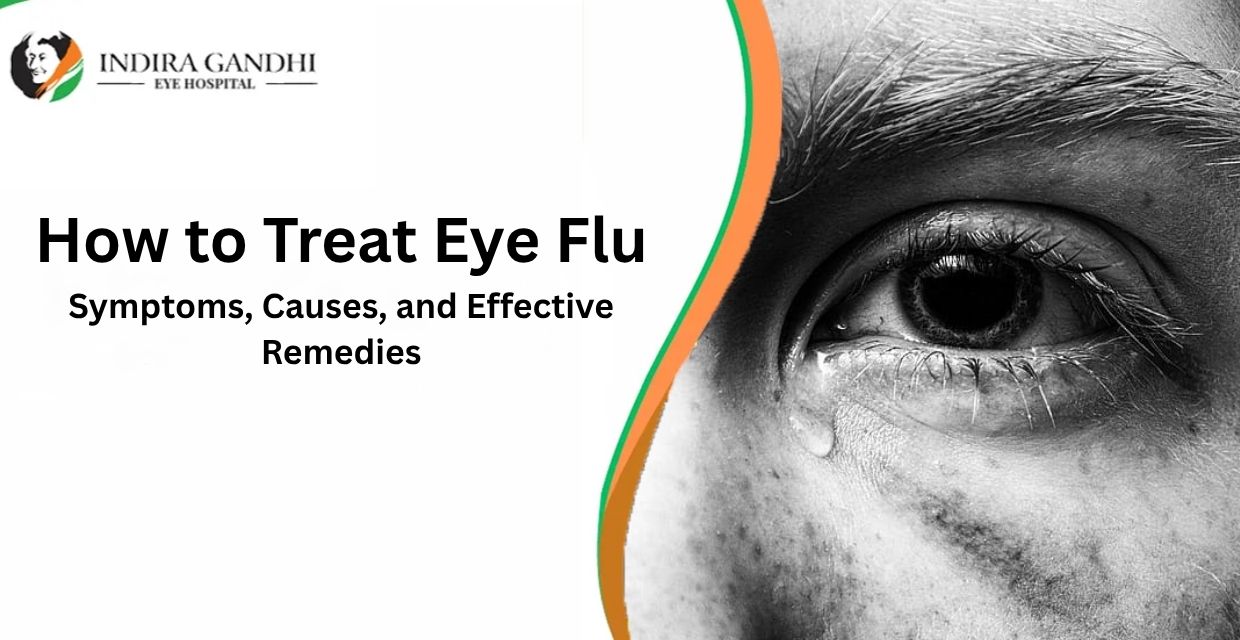|
Getting your Trinity Audio player ready...
|
Eye flu, also referred to as viral conjunctivitis, is a widespread and highly contagious infection that impacts the transparent membrane (conjunctiva) of the eye. While it may not always pose a serious threat to vision, it can cause significant discomfort and disrupt daily activities. Understanding how to treat eye flu effectively can make a big difference in speeding up recovery, preventing transmission, and protecting your eye health. This in-depth blog post will explore the symptoms, causes, and proven remedies for managing and curing eye flu efficiently.
What is eye flu?
Eye flu is an inflammation of the conjunctiva, the clear membrane that lines the eyelids and covers the white part of the eyeball. The condition is commonly caused by viruses such as adenoviruses—the same type responsible for respiratory illnesses. This infection is extremely contagious and can spread rapidly through direct or indirect contact. With increasing urbanization and environmental pollutants, more people are seeking information on how to treat eye flu and prevent its recurrence.
For comprehensive understanding of eye conditions affecting the cornea and surrounding tissues, it’s important to recognize that viral conjunctivitis is just one of many conditions that can affect eye health.
Symptoms of Eye Flu
Early recognition of symptoms is vital when determining how to treat eye flu. Below are common signs to watch for:
- Redness in one or both eyes
- Itching, irritation, or a gritty sensation
- Watery or thick discharge
- Swollen eyelids
- Light sensitivity
- Excessive tearing
- Blurred vision (in more severe cases)
- Mild fever or cold symptoms
Typically, symptoms begin in one eye and often spread to the other within a few days. The symptoms can persist for up to two weeks if not properly managed.
Causes of Eye Flu
To effectively learn how to treat eye flu, it’s essential to understand what causes it:
- Viral Infections: Adenoviruses are the most common culprits, transmitted via respiratory droplets or contaminated surfaces.
- Bacterial Infections: Though less common in “eye flu,” bacteria like Staphylococcus and Streptococcus can lead to conjunctivitis.
- Poor Hygiene: Touching the eyes with dirty hands or using shared items like towels and cosmetics.
- Contaminated Surfaces: Objects such as phones, door handles, and keyboards can harbor the virus.
- Weakened Immune System: A low immunity level increases susceptibility to infections.
Recognizing the specific cause is fundamental to developing a personalized strategy for how to treat eye flu effectively.
How to Treat Eye Flu: Home-Based and Medical Remedies

Knowing how to treat eye flu involves combining hygiene practices, soothing remedies, and medical treatments when needed. Here’s a comprehensive guide:
1. Maintain Rigorous Hygiene
One of the most critical aspects of how to treat eye flu is hygiene:
- Wash your hands regularly with soap and water.
- Avoid touching or rubbing your eyes.
- Use clean, personal towels and pillowcases.
- Disinfect commonly used surfaces like remotes and doorknobs.
- Avoid sharing cosmetics or eyewear.
2. Apply Cold Compresses
A cold compress can help soothe swelling and irritation. Use a clean, damp cloth chilled in the refrigerator and apply it gently to the closed eye for relief. Always use a separate cloth for each eye to avoid cross-infection.
3. Use Artificial Tears or Lubricating Eye Drops
These over-the-counter solutions can help flush out irritants and provide relief from dryness and discomfort. When exploring how to treat the eye flu, make sure the drops do not contain preservatives or vasoconstrictors.
4. Discontinue Use of Contact Lenses
Contact lenses can exacerbate the irritation and harbor infectious agents. Switch to glasses until your eyes have completely healed. For those considering vision correction alternatives, explore refractive and optical solutions that might be suitable post-recovery.
5. Consider Over-the-Counter Pain Relief
If your eye flu causes significant discomfort, consider using non-prescription pain relievers like ibuprofen or acetaminophen. This supports your comfort as you treat the eye flu properly.
6. Allow Your Eyes to Rest
Reducing screen time, getting adequate sleep, and avoiding eye strain are supportive steps that aid in healing.
7. Clean Bedding Frequently
Change and wash your pillowcases, bed sheets, and towels in hot water every few days to prevent reinfection.
8. Use Medicated Eye Drops (If Prescribed)
In more severe or prolonged cases, a doctor might prescribe antiviral or antibiotic eye drops. Follow the dosage instructions closely for effective recovery.
When to See a Doctor or Visit the Best Eye Hospital
If your symptoms persist beyond 10 days or worsen significantly, it’s crucial to consult a healthcare professional. Warning signs include:
- Sharp or intense eye pain
- Persistent or worsening redness
- Yellow or green discharge
- Blurred vision that doesn’t improve
- Increased light sensitivity
For precise diagnosis and advanced treatment, consider visiting leading eye care facilities. Expert ophthalmologists and cutting-edge technology at such facilities ensure accurate care tailored to your needs. If you’re in the Delhi-NCR region, specialized eye hospitals in Delhi provide comprehensive viral conjunctivitis treatment.
How to Treat Eye Flu in Children and the Elderly
Children are particularly prone to eye flu due to frequent physical contact in schools. Elderly individuals often have compromised immune systems. Here’s how to treat eye flu in these sensitive groups:
- Teach children the importance of hygiene.
- Keep infected children at home until fully recovered.
- Consult pediatric ophthalmologists when symptoms persist.
- For seniors, ensure a sterile environment and provide adequate hydration and nutrition.
For specialized care in children, pediatric ophthalmology services can ensure that age-appropriate treatment is administered safely and effectively.
Myths vs. Facts
When learning how to treat eye flu, busting common myths is essential:
- Myth: Eye flu spreads by looking at someone. Fact: It spreads through direct contact or contaminated items.
- Myth: Antibiotics are a cure-all. Fact: Antibiotics work only for bacterial, not viral, infections.
- Myth: Home remedies are always safe. Fact: Some may irritate the eyes or worsen symptoms.
Natural and Home Remedies That Complement Treatment
If you’re exploring gentle, natural ways to treat eye flu, consider these remedies:
- Chamomile Tea Bags: After steeping and cooling, use them as a compress to reduce swelling.
- Cucumber Slices: Apply over closed eyelids to ease irritation.
- Aloe Vera Gel: Apply around (not in) the eyes for anti-inflammatory effects.
- Honey and Warm Water Wash: Mix a small amount of raw honey with warm water for an eye rinse—consult a doctor before use.
How to Treat Eye Flu and Support Long-Term Eye Health
Post-recovery, continue these habits to maintain strong eye health:
- Practice daily hygiene.
- Schedule regular eye exams with experienced doctors.
- Wear sunglasses or protective eyewear in dusty environments.
- Maintain a healthy diet rich in vitamins A, C, and E.
- Stay hydrated and reduce excessive screen time.
Preventive Tips: Stop It Before It Starts
Preventing the infection is as important as knowing how to treat the eye flu. Follow these tips:
- Avoid sharing personal items.
- Clean glasses and sunglasses regularly.
- Boost your immune system with a nutritious diet.
- Use a hand sanitizer when soap isn’t available.
Why Professional Eye Care Matters
Professional care ensures correct diagnosis, appropriate treatment, and faster healing. Quality eye care facilities offer:
- Access to expert ophthalmologists
- State-of-the-art diagnostic tools
- Customized treatment plans
- Continuous follow-up care
For those in different regions, comprehensive care is available at multiple locations, including Gurgaon, Lucknow, and Amethi hospitals. Choosing expert care is not just about treating the current infection—it’s about safeguarding your long-term vision.
Conclusion
Understanding how to treat eye flu is essential for preventing discomfort, speeding up recovery, and protecting those around you from the contagious nature of the infection. By recognizing the symptoms early, maintaining proper hygiene, and using effective home remedies, most cases of eye flu can be managed effectively. However, in more severe or persistent cases, it’s important to consult a healthcare professional or visit specialized eye care facilities for thorough evaluation and treatment.
Prevention plays a significant role in managing eye flu, so practicing good hygiene habits and avoiding close contact with infected individuals can help minimize the risk. Additionally, supporting your eyes with the right diet and protective measures will go a long way in maintaining long-term eye health.
By following these steps, you can ensure a quicker recovery and reduce the risk of spreading the infection to others. For any concerns or persistent symptoms, don’t hesitate to contact Indira Gandhi Eye Hospital care specialists who can provide personalized treatment plans. Ultimately, taking early action and seeking professional care when needed can help you recover safely and protect your vision.
Frequently Asked Questions (FAQs)
How long does eye flu last?
Eye flu typically lasts 7 to 14 days. Most cases improve with home care, but if symptoms worsen or last beyond 10 days, it’s advisable to see a doctor. Seeking timely treatment from an experienced eye specialist can reduce complications and recovery time.
Can eye flu cause permanent damage?
In most cases, no. Viral conjunctivitis is usually self-limiting and doesn’t affect vision long term. However, if improperly treated or if the infection becomes severe, it may lead to corneal inflammation. That’s why knowing how to treat eye flu properly and when to consult a doctor is crucial.
Is it safe to go to school or work with eye flu?
No. Since eye flu is contagious, it’s best to stay home until symptoms subside—usually 5–7 days after onset. This helps prevent infecting others. Children, in particular, should avoid school to reduce the risk of spreading the infection in classrooms.
Can I use antibiotic eye drops for eye flu?
Only if prescribed by a doctor. Most eye flu cases are viral, and antibiotics do not work on viruses. Using them unnecessarily may irritate the eyes or delay healing. An eye specialist will determine if your condition is bacterial or viral and prescribe appropriate medication.












